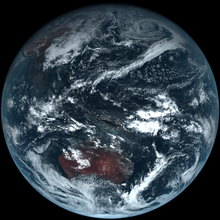Himawari 8
| Himawari 8 | |
|---|---|
| Type: | Weather satellite |
| Country: |
|
| Operator: | JMA |
| COSPAR-ID : | 2014-060A |
| Mission dates | |
| Dimensions: | 3500 kg |
| Size: | 8 m long |
| Begin: | October 7, 2014, 05:16 UTC |
| Starting place: | Tanegashima |
| Launcher: | H-2A 202 F-25 |
| Status: | active |
| Orbit data | |
| Track height: | 35,800 km |
Himawari 8 (Sunflower 8) is a weather satellite of the Japanese Meteorological Agency JMA ( Japan Meteorological Agency ). It is the eighth geostationary weather satellite in Japan and the first of a new series. He replaced Himawari 7 (MTSAT-2), who had been in service since 2006.
mission
Himawari 8 was launched into Earth orbit on October 7, 2014 at 05:16 UTC by an H-2A launcher from Ramp 1 of the Yoshinobu launch complex at Tanegashima Space Center, Japan , and reached its geostationary position at 140 ° East on May 16. October. The first images were received on December 18, 2014, and the satellite went into operation on July 7, 2015.
In order to minimize weather influences, two receiving stations are operated in parallel in Japan: the main station in the Kantō region and a replacement station at Ebetsu on the island of Hokkaidō .
construction
The satellite was built on the basis of the DS 2000 satellite bus from Mitsubishi Electric and has a planned service life of 8 years. It is equipped with three sets of devices. The Advanced Himawari Imager (AHI) is the main instrument of the spacecraft. It is a multispectral camera with sixteen channels (0.46–13.3 µm) that will provide overview and detailed images in the visible light and infrared range . The images achieve a resolution of up to 500 meters and provide data on cloud cover, temperature, wind, precipitation and aerosol distribution in the various spectral ranges . The Space Environment Data Acquisition Monitor (SEDA) collects data about protons and electrons in space. The Data Collection Subsystem (DCS) is the communication payload and is used to collect and forward the data to the ground weather stations via the Ka-band .
Replacement / successor
Himawari 9 was launched on November 2, 2016 and was also positioned at 140 ° E. It is supposed to replace the Himawari 8 at the end of its service life , but earlier in the event of a defect.
Web links
- Manufacturer website
- JMA: Himawari-8/9 (English)
- Observing Systems Capability Analysis and Review Tool
Individual evidence
- ↑ a b Japan Meteorological Agency: Himawari-8 operation initiated. (PDF) July 7, 2015, accessed on July 8, 2015 .
- ↑ The Orion: Himawari 8 in orbit , accessed October 24, 2014
- ↑ Japan Meteorological Agency: Himawari-8 enters geostationary orbit. (PDF) October 17, 2014, accessed on December 18, 2014 (English).
- ^ Japan Meteorological Agency: First images from Himawari-8. December 18, 2014, accessed December 18, 2014 .
- ↑ a b Japan Meteorological Agency: Himawari-8/9. Retrieved December 18, 2012 .
- ↑ Japan Meteorological Agency: New geostationary meteorological satellites - Himawari-8/9 -. (PDF) March 26, 2014, accessed October 24, 2012 (English / Japanese).
- ↑ NASASpaceFlight.com: Japan lofts Himawari 8 weather satellite via H-IIA rocket , accessed October 24, 2014

